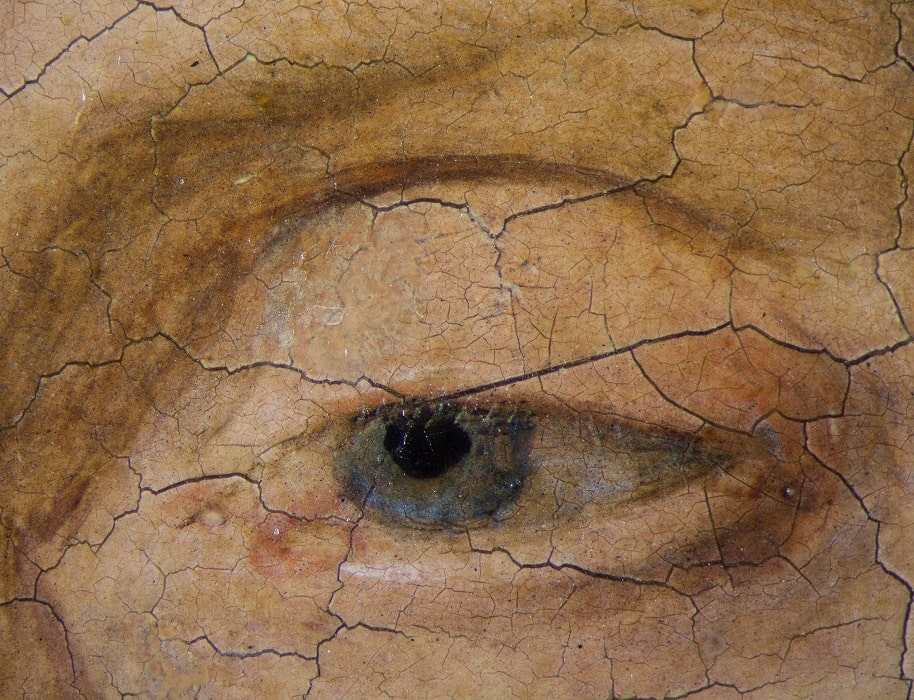No other painter in the history of European art was able to reproduce the details of his reality with comparable brilliance and precision as the founder of Old Netherlandish painting: Jan van Eyck. An interactive digital projection now makes it possible in the Berlin Gemäldegalerie to immerse oneself in the tiniest subtleties of his masterpieces. In addition, the exhibition starting on 20 October 2023 presents original van Eyck works from the museum’s own holdings and sheds light on the art-technological examination and restoration of selected paintings.
Fig. above: Jan van Eyck, Portrait of a Man with a Red Chaperone, detail, c. 1435/40, © Staatliche Museen zu Berlin, Gemäldegalerie / Jörg P. Anders
At the centre of the exhibition in the Gemäldegalerie’s Wandelhalle is a digital projection of Jan van Eyck’s works, developed by the Royal Institute for Artistic Heritage (KIK-IRPA) in Brussels. With the help of the projections, the viewers can interactively “zoom in” from the overall view of the paintings into detail shots and determine the image section themselves. The enlargements show tiny details of the works in high-resolution at wall size. Details such as eyes, mouths or hands can be compared with each other, and the tiniest subtleties, from the hairs or pupils of the figures to the brushstrokes of the master, can be traced.
The projection is based on extremely high-resolution photos of all 33 surviving paintings as well as some of Jan van Eyck’s miniatures, which were made as part of the Van Eyck Research in Open Access project, VERONA for short, conducted by KIK-IRPA between 2014 and 2020. The presentation aroused great public interest in Brussels in 2020/21 and will now be shown in Germany for the first time. It makes it possible to immerse oneself in masterpieces such as van Eyck’s “Ghent Altarpiece” in St. Bavo in Ghent, the “Madonna of Chancellor Rolin” in the Louvre in Paris, the so-called “Arnolfini Wedding” in the National Gallery in London or the famous “Church Madonna” in the Berlin Gemäldegalerie down to the smallest details that are hardly or not at all visible to the naked eye in front of the originals.

Accompanying the exhibition, the Gemäldegalerie shows its holdings of original works by Jan van Eyck and his circle. With three undisputed originals by his hand, including one of his major works, the “Church Madonna”, and two paintings created at least in the master’s studio, as well as four early copies, the Gemäldegalerie possesses an unusually rich stock of works by van Eyck. The interplay of the high-resolution projection with van Eyck’s originals opens up the fascination of his brilliant painting with its impressive richness of detail in a completely new way.
A third chapter of the exhibition highlights the art-technological investigations and restorations of three of van Eyck’s works in the Gemäldegalerie. The systematic art-technological examinations have been carried out since 2015 as part of the compilation of a scientific inventory catalogue of Dutch and French painting of the 15th century. Here, restorers and art historians, a technical photographer and a wood biologist worked together in the Gemäldegalerie in an interdisciplinary manner. The restorations concerned, among others, two major works of the Gemäldegalerie: the portrait of Baudouin de Lannoy and the so-called Arnolfini portrait. In addition to conservation measures to secure the layers of the painting, the conservator also removed heavily aged, later overlays and overpaintings on the painting.

Jan van Eyck (c. 1399-1441) is considered the most important Flemish artist of the late Middle Ages. From 1425 he worked at the court of Burgundy for Philip the Good and built up an international network of important clients. Between 1432 and 1435 he created what is probably his most famous work, the “Ghent Altarpiece”, before settling in Bruges with his own workshop. Van Eyck’s naturalistic depiction of the visible world heralded a new artistic epoch north of the Alps on the threshold of the modern age.
“Zoom on van Eyck. Masterpieces in Detail” is curated by Stephan Kemperdick, curator for German, Dutch and French painting before 1600, and Sandra Stelzig, restorer at the Gemäldegalerie.
WHERE?
Gemäldegalerie
Kulturforum
Matthäikirchplatz
10785 Berlin-Tiergarten
WHEN?
Tuesday – Friday 10 am – 6 pm
Thursday 10 a.m. – 8 p.m.
Saturday + Sunday 10 am – 6 pm






